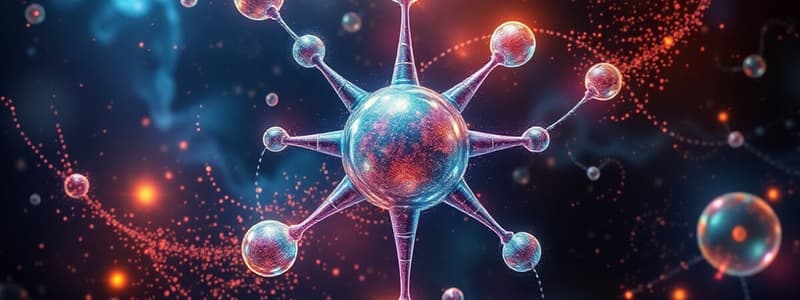Podcast
Questions and Answers
Which of the following lists the four most abundant elements found in living organisms?
Which of the following lists the four most abundant elements found in living organisms?
- Carbon, nitrogen, oxygen, sodium
- Carbon, hydrogen, oxygen, sodium
- Carbon, hydrogen, oxygen, iron
- Carbon, hydrogen, oxygen, nitrogen (correct)
Which of these is considered a trace element in the human body?
Which of these is considered a trace element in the human body?
- Oxygen
- Zinc (correct)
- Hydrogen
- Nitrogen
Which of the following statements about matter is incorrect?
Which of the following statements about matter is incorrect?
- All life forms are composed of matter.
- All matter must exist as compounds. (correct)
- All matter is made up of elements.
- All matter has mass and takes up space.
Which of the following best defines a compound?
Which of the following best defines a compound?
Which subatomic particles are located in the nucleus of an atom?
Which subatomic particles are located in the nucleus of an atom?
An atom contains 7 protons, 8 neutrons and 7 electrons. What's its atomic mass?
An atom contains 7 protons, 8 neutrons and 7 electrons. What's its atomic mass?
An isotope of potassium has 19 protons, 18 electrons and 21 neutrons. What is its mass number?
An isotope of potassium has 19 protons, 18 electrons and 21 neutrons. What is its mass number?
What type of bond is formed when two atoms share electrons?
What type of bond is formed when two atoms share electrons?
Flashcards
What are the four most common elements in living organisms?
What are the four most common elements in living organisms?
The four most common elements found in living organisms are carbon (C), hydrogen (H), oxygen (O), and nitrogen (N).
What is a trace element?
What is a trace element?
A trace element is an element that is present in very small amounts in a living organism. These elements are often essential for life, but they are needed in much smaller quantities than the four most common elements.
What is Matter?
What is Matter?
Matter refers to anything that occupies space and has mass. All living organisms are composed of matter.
What is a compound?
What is a compound?
Signup and view all the flashcards
What particles are found in the nucleus of an atom?
What particles are found in the nucleus of an atom?
Signup and view all the flashcards
How is the atomic mass of an atom calculated?
How is the atomic mass of an atom calculated?
Signup and view all the flashcards
What is a covalent bond?
What is a covalent bond?
Signup and view all the flashcards
What is a hydrogen bond?
What is a hydrogen bond?
Signup and view all the flashcards
Study Notes
Common Elements in Living Organisms
- Four most common elements in living organisms are carbon (C), hydrogen (H), oxygen (O), and nitrogen (N).
Trace Elements
- Zinc (Zn) is a trace element in the human body.
Matter and Elements
- All living things are composed of matter.
- All matter has mass and is composed of elements.
- Not all matter exists as compounds.
Compounds
- Compounds are formed when two or more different elements combine in a fixed ratio.
- Sodium chloride (table salt) is an example of a compound.
Atomic Structure
- The nucleus of an atom contains protons and neutrons.
- Electrons orbit the nucleus.
Atomic Mass and Number
- Atomic mass is the sum of protons and neutrons in an atom.
- Mass number is the same as the atomic mass of an atom.
Chemical Bonds
- A covalent bond forms when two atoms share electrons.
- An ionic bond forms when one atom donates an electron to another atom.
Formation of Table Salt
- Table salt (NaCl) forms when sodium donates its outer electron to chlorine.
Water Molecules
- Water molecules are held together by polar covalent bonds.
Weak Bonds
- Hydrogen bonds are weak bonds that hold molecules together.
Chemical Reactions
- In a chemical reaction, reactants form products.
- The equation 2H₂ + O₂ → 2H₂O shows reactants (H₂ and O₂) forming products (H₂O).
Water Properties
- Cohesion is the tendency of water molecules to stick together.
pH Scale
- A pH of 7 is neutral.
- A pH of 3 is strongly acidic.
Studying That Suits You
Use AI to generate personalized quizzes and flashcards to suit your learning preferences.
Description
This quiz covers fundamental concepts about the common elements in living organisms, trace elements, and the basic structures of matter. It explores the formation of compounds, atomic structure, and chemical bonds. Test your understanding of these essential topics in biology.




